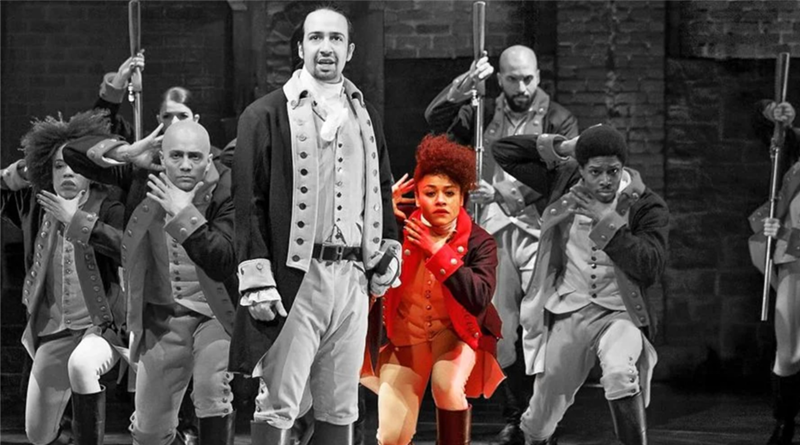These thoughts were written by Claire, one of our 2020 summer interns. The opinions expressed herein do not reflect those of Civitas other than respect for the value of open dialogue.
Hamilton, a story of America then told by America now. Before the chaos of COVID-19, I was fortunate enough to have seen Hamilton in real life, and with the release of its movie version on Disney Plus, I got to experience the show’s magic all over again. After watching both versions of the production, I realized there were some things that I had noticed in the movie, but that I didn’t catch in the live musical production. Being the curious, life-long learner that I am, I decided to dig deeper into this topic and see what all I might’ve missed in both versions of the production. Unsurprisingly, there turned out to be a ton of stuff that I missed, so I wanted to share my newly found knowledge with you all in case I’m not the only one lacking an “eye” for the theatre. My goal with this post is to have you learn at least one new thing about this production, even if you’re the most well-versed Hamilton superfan on the planet.
To begin, let’s talk about camera angles. It’s not surprising that when watching Hamilton the movie, you are able to view the characters from perspectives that you wouldn’t have been able to experience had you been seated at the top of the nosebleeds section or behind someone with a really big head. The movie features aerial shots of the set, up-close shots of characters, and even one view from the back of the stage looking out into the empty audience. (Hamilton the movie was a combination of three performances, including one in an empty theater).
During the song “Satisfied,” the camera zooms in and out on Angelica’s face in a subjective way in order to help the viewer experience the confusion going on in Angelica’s mind throughout the scene, which is something that you would not have experienced at the live show. Throughout Hamilton, the stage rotates both counterclockwise (to represent the passage of time) and clockwise (to represent a character’s resistance to the inevitable). Hence why the stage rotates clockwise while Angelica sings “Satisfied.” The stage is also circular in order to represent the “whirlwind of history” that encompasses Hamilton’s life, and the real life hurricane that hit the island on which he was born.
As I previously mentioned, Hamilton the movie was a combination of three separate performances, so it comes to no surprise that there was a “movie mistake” discovered in the final production. If you have a keen eye, then you might have noticed this mistake which was that the flowers on Angelica’s dress disappear and then reappear throughout “Satisfied.” Don’t believe me? Check out this clip and see for yourself.
Next, we have the hidden details of Hamilton’s incredible set design, which is more intricate than one might think. For starters, the brick wall that is seen in the background of the set is only partially built at the start of the show, as a way to represent a colonial-era building under construction, since at the time, the country was very much in its formative years. However, between acts, the brick wall grows taller to symbolize the continuous work being done on the country and its growing foundation. Additionally, the nautical elements placed throughout the set (ropes, pulleys, etc.) are meant to illustrate the arrival of immigrants to this country (including Hamilton), who often came to the U.S. by ship.
If none of this has surprised you thus far, keep reading because I’m sure this next one will blow your mind! Not only does actress Ariana DeBose play a member of the incredibly talented Ensemble in the show, but she also plays the hidden role of the Bullet. Scroll to the top of this post to see the Bullet highlighted next to Hamilton. Now of course this name makes sense due to the actress’s physical portrayal of a slow motion bullet aimed toward Hamilton. However, throughout the entire show, the Bullet is used to foreshadow Death based on her interactions with specific characters. For instance, the Bullet (dressed as a soldier) is seen shaking hands with John Luarens after killing a red coat, and he soon dies of a gun wound. Additionally, the Bullet is seen flirting with a young Philip Hamilton, and she even directs Philip to the man who would ultimately cause his undoing. With Hamilton himself, the Bullet is even more present. The first interaction she has with Hamilton is during the first song of the show when Aaron Burr raps a line about Hamilton’s plan for the future, and suddenly Hamilton hands a book to the Bullet, indicating that she will have a significant role in his future. Immediately after he hands the book off, the entire Ensemble, including the Bullet, points a finger to the sky, and this action is repeated throughout the show in order to imitate Hamilton pointing his gun at the sky during the final duel. During “Ten Duel Commandments,” the Bullet stands right next to Hamilton while the line “pick a place to die while it’s high and dry” is sung. To make matters even worse, the Bullet is the one to hand Aaron Burr the quill when he starts writing his letters to Hamilton, which ultimately end with their duel.
Okay if none of that surprised you in the slightest, then I truly believe that you might be the most well-versed Hamilton superfan on the planet, on par with Lin-Manuel himself. Thanks for reading! Feel free to leave a comment below about something neat you learned!


Pingback:Index of 2020 Intern Student Blog Posts - CIVITAS-STL